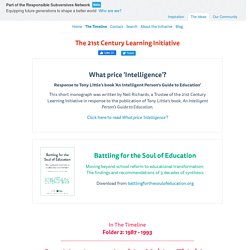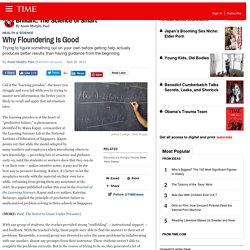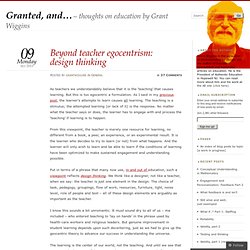

EdTech Books. Cognitive Apprenticeship: Making Thinking Visible. 1.

Domain knowledge includes the concepts, facts, and procedures explicitly identified with a particular subject matter; these are generally explicated in school textbooks, class lectures, and demonstrations. This kind of knowledge, although certainly important, provides insufficient clues for many students about how to solve problems and accomplish tasks in a domain. Moreover, when it is learned in isolation from realistic problems contexts and expert problem-solving practices, domain knowledge tends to remain inert in situations for which it is appropriate, even for successful students. And finally, although at least some concepts can be formally described, many of the crucial subtleties of their meaning are best acquired through applying them in a variety of problem situations.
Indeed, it is only through encountering them in real problem solving that most students will learn boundary conditions and entailments of much of their domain of knowledge. 2. 3. 4. Cognitive Apprenticeship: Making Thinking Visible. This article has exercised a great influence on the 21st Century Learning Initiative’s thinking.

It originally appeared in the Winter, 1991 issue of American Educator, the journal of The American Federation of Teachers, and is reprinted here with permission. In ancient times, teaching and learning were accomplished through apprenticeship: We taught our children how to speak, grow crops, craft cabinets, or tailor clothes by showing them how and by helping them do it. Apprenticeship was the vehicle for transmitting the knowledge required for expert practice in fields from painting and sculpting to medicine and law.
It was the natural way to learn. In modern times, apprenticeship has largely been replaced by formal schooling, except in children’s learning of language, in some aspects of graduate education, and in on-the-job training. While there are many differences between schooling and apprenticeship methods, we will focus on one. Toward a Synthesis of Schooling and Apprenticeship. Anne Murphy Paul: Why Floundering Makes Learning Better. Call it the “learning paradox”: the more you struggle and even fail while you’re trying to master new information, the better you’re likely to recall and apply that information later.

The learning paradox is at the heart of “productive failure,” a phenomenon identified by Manu Kapur, a researcher at the Learning Sciences Lab at the National Institute of Education of Singapore. Kapur points out that while the model adopted by many teachers and employers when introducing others to new knowledge — providing lots of structure and guidance early on, until the students or workers show that they can do it on their own — makes intuitive sense, it may not be the best way to promote learning.
Rather, it’s better to let the neophytes wrestle with the material on their own for a while, refraining from giving them any assistance at the start. (MORE: Paul: The Secret to Grace Under Pressure) With one group of students, the teacher provided strong “scaffolding” — instructional support — and feedback. Six Quick Tips If You're Suddenly Teaching STEM. Fall has arrived, school doors have reopened for many students across the USA, and quite a few educators face a fresh and potentially daunting assignment: Teach STEM.

STEM, it seems, has finally reached Education Buzzword of the Year status. Novice teachers, experienced teachers, and even administrators are being asked to create STEM classes, often with inadequate know-how or support. I know this from all the pleas for help in my own daily email! Let’s read about some real situations educators are dealing with. (I’ve changed the names and locations.) My name is Jane and I was a kindergarten teacher. Can you hear a touch of panic in some of these voices?
Beyond teacher egocentrism: design thinking. As teachers we understandably believe that it is the ‘teaching’ that causes learning.

But this is too egocentric a formulation. As I said in my previous post, the learner’s attempts to learn causes all learning. The teaching is a stimulus; the attempted learning (or lack of it) is the response. No matter what the teacher says or does, the learner has to engage with and process the ‘teaching’ if learning is to happen. From this viewpoint, the teacher is merely one resource for learning, no different from a book, a peer, an experience, or an experimental result. Put in terms of a phrase that many now use, in and out of education, such a viewpoint reflects design thinking. I know this sounds a bit unromantic. The learning is the center of our world, not the teaching. What all good designs have in common.